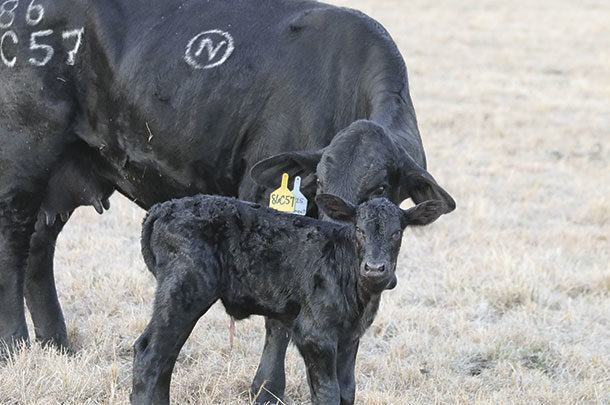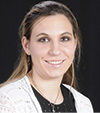Thanks to years of data collection and careful research, reliable expected progeny differences (EPDs) play a vital role in mating selections. Two of these frequently used for heifers and risky cows are Calving Ease Direct (CED) and Birth Weight (BW).
Calving Ease Direct is reported in percentage units, with the higher number correlated to a lesser risk of dystocia. For example, a bull with a +5 would expectedly have five more calves out of 100 born unassisted to heifers. This EPD is especially valuable as a comparison tool between two bulls or a single bull against the average.
“Percentile rankings from the EPD database from a specific genetic evaluation database are also helpful in ranking animals based upon their EPDs in the particular population or class of animals,” explains Dr. Sally L. Northcutt of Method Genetics LLC. “Many bull buyers reference the non-parent EPD averages and EPD percentiles in specific cattle populations when purchasing young bull prospects.”
For BW, unlike CED, a lower number is preferred. Reported in expected average pounds of birthweight, this EPD was the industry go-to in selecting a bull for heifers before CED was available.
What’s the difference?
A foundation of the calving ease principle is the approximate size of calves thrown by a given bull. This is why birthweight was the gold standard in the industry for so long. But CED took this a step further.
“Rather than distinguishing between the two, it’s important to utilize all sources of phenotypic information, in this case birthweight and calving scores in a multitrait genetic evaluation to create calving ease EPDs,” explains Northcutt. “These are targeted at the economically relevant traits and birthweights, used in the calving ease models as indicator traits.”
Calf birthweight is considered an indicator trait because it is genetically correlated with CED, but it doesn’t fully account for the many genetic variations in actual calving ease performance of bulls.
Dr. Bob Weaber of Kansas State University explains, “Birthweight is negatively correlated with calving ease. As Birth Weight goes up, expected number of dystocia-free or unassisted calvings goes down. Birthweight, however, is slightly positively correlated with the Calving Ease Maternal (CEM) EPD.”
A downward selection on BW will make a sire’s daughters more difficult calvers. This is reasonable because BW has a positive genetic correlation with weaning, yearling and mature cow weights.
“Note that Calving Ease Direct is slightly negatively correlated with maternal calving,” says Weaber. “Therefore, selection for bulls to produce replacement heifers should include both CED and CEM.”
Ira Wines of the Ellison Ranching Company based out of Tuscarora, Nevada, oversees the A.I. of nearly 1,800 heifers a year. Smooth calvings are paramount for their young animals, requiring strict standards for both CED and BW EPDs on A.I. and cleanup bulls.
“We don’t go outside of what we’re looking for,” says Wines. “Last year, we had one ranch calve out about 675 heifers; by the time they were done, they only had to pull about 12 calves out of them all. We’ve really nailed down the EPDs to help us out.”
Their protocol sets a minimum CED of +10 for their bulls, along with a maximum birthweight of 75 pounds; a negative BW is always preferred. Ira notes that while a bull might fit the CED criteria, they may still have actual birthweights that are over 75 pounds.
“Because our heifers are moderate-framed, an 80-pound calf won’t work for us,” he says. “A bull might be off the charts on every other number we’re looking at, but have a 76-pound birthweight, and we won’t use him.”
Making it work in your operation
To minimize risk of dystocia, producers should focus on CED. It does come with some economic considerations relative to your specific market and end goals. Correlated with a lot of other traits, CED is very economically relevant and influences not only BW, but also other dystocia influences.
“Downward selection on BW only should be avoided as it has a genetic association with maternal calving ease performance. BW is also correlated with economically important growth traits that are often market endpoints,” says Weaber. “Selection downward on BW may decrease growth performance and revenue generated through sale weights.”
He recommends producers avoid selecting sires for mature cows with focus solely on calving ease, as often times these very high CED scoring bulls give up lots of performance for growth. Likewise, a bull for heifers should still have adequate calving numbers to minimize dystocia in a production environment.
“Excessively high CED EPDs are sometimes associated with calves that are very short gestation and light birthweights,” he explains. “In certain cold environments, these calves that are very small, say 50-pound birthweights, may experience higher calf mortality due to hypothermia and failure of immune transfer via low colostrum intakes.”
In the case of the Ellison Ranching Company, animals aren’t sold until they are yearlings. Everything is either retained as replacements or sold directly to the feedlot. This situation requires less emphasis on birth and weaning weights. “We had a bull whose calves weighed about 60 pounds when they were born. Within a month they had caught up to calves that weighed 75 pounds. When they were born, they had a lot of growth potential in them.
“We might give up some growth, but we’re putting more emphasis on getting a live calf out of a heifer than what that calf’s going to grow up to be,” says Wines. He notes that sometimes, in spite of being high for calving ease, a bull will still throw very prolific calves.
Across the industry, there is agreement the combination of different EPDs and other phenotypic traits are necessary for optimal bull selection.
Northcutt further adds, “Cow-calf producers should utilize calving ease EPDs whenever available. These genetic selection tools come from a multitrait genetic evaluation that includes available birthweight data as well as calving score data. As a reminder, beef cattle genetic evaluations also simultaneously incorporate pedigree and available genomic information as part of the models too.”
This principle is regularly put into real world practice.
“We won’t just buy a bull based on the numbers; phenotypically they’ve got to have that spring of rib and depth,” says Wines of their bull selection. “Sometimes you’ve got to give up some of that on heifer bulls; that’s what makes them calving ease bulls. We still look at them, and we’ll cull some of them based on the phenotype.” ![]()
PHOTO: Ease of calving is extremely important for heifers. Calving Ease Direct and Birth Weight are two primal EPDs that can help producers select the best bulls to accomplish this. A good understanding of how the two work and how they are different ensures both can be used in conjunction for a successful calving season. Photo by David Cooper.
Jaclyn Krymowski is a freelancer based in Ohio.









